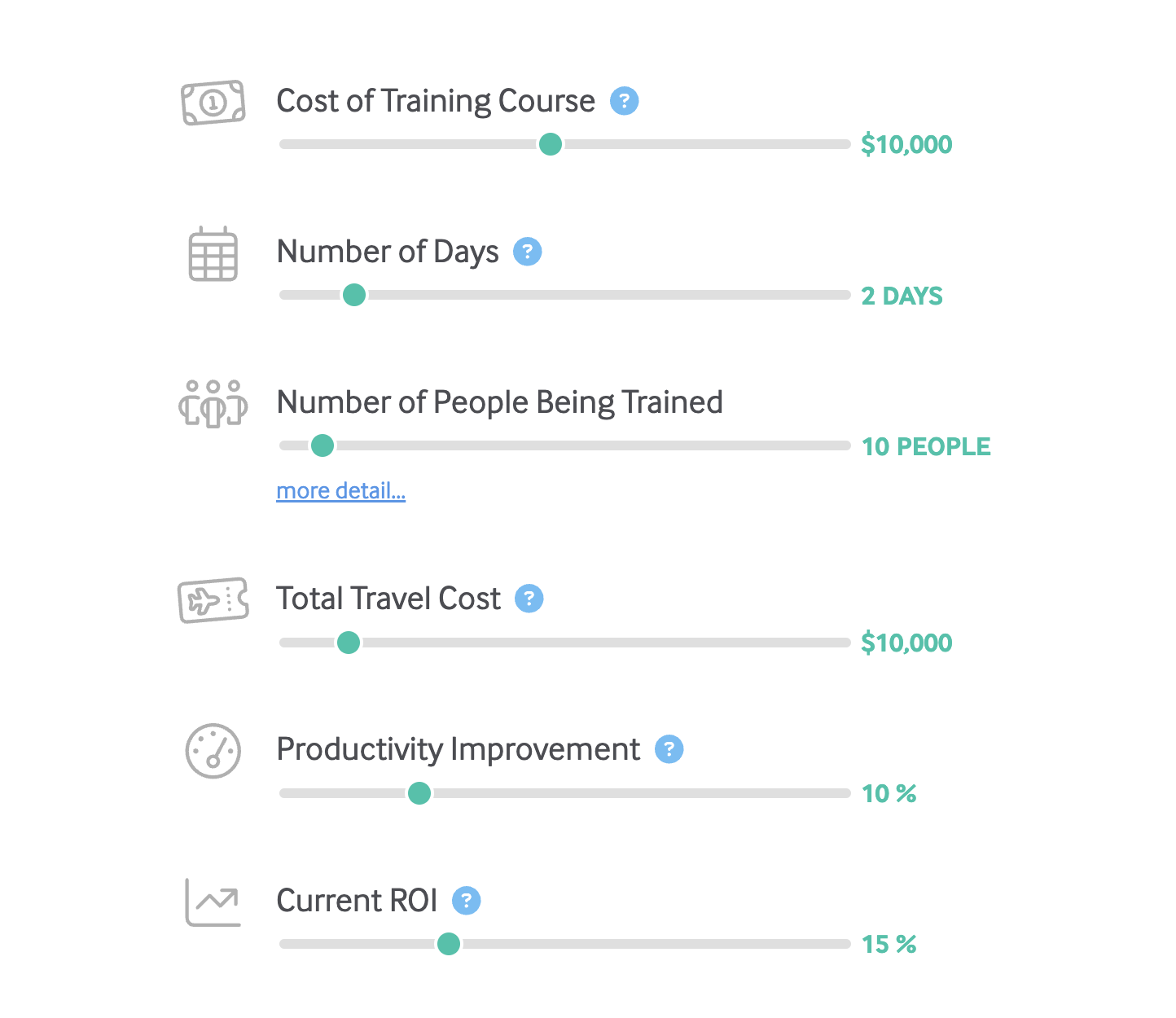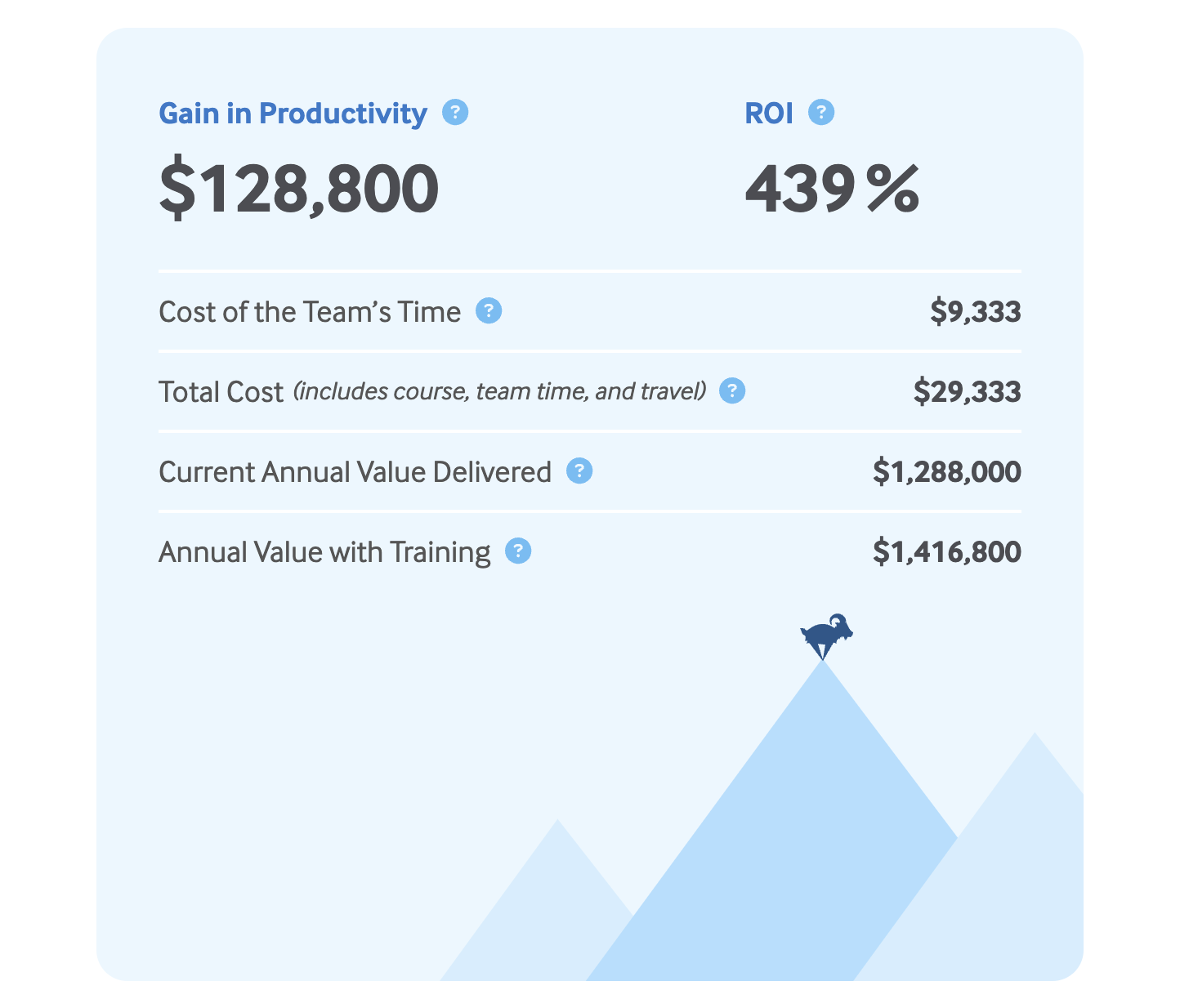Agile Training Return on Investment Calculator
To determine return on investment for agile training, we need to estimate both the benefits and cost of the training as given in this formula:

To make this calculation easy, use the agile training return on investment calculator later in this article. If you can’t wait, jump right to the calculator. But you’ll get better results if you read the short sections on benefits and costs.
Let’s begin with estimating the benefits.
Estimating the Benefits of Agile Training
Agile training, like any training, comes with a cost. But are the benefits worth it?
The short answer is yes. Evidence shows that the investment in agile training–for teams, leaders, and individuals–pays off. Teams that are well grounded in agile guidelines and principles (which includes formal agile training) accelerate organizational effectiveness, leading to the following benefits:
- 30% gains in efficiency, customer satisfaction, employee engagement and operational performance (McKinsey)
- Cut time to value in half and reduces post-release defects by 75% (Broadcom)
- 5-10x faster (McKinsey) and 60% more productive (Broadcom)
To fully estimate the benefits of an agile training program there are many factors you could consider. But to make it easy, the calculator focuses on just one: productivity.
Productivity
Productivity can be broadly defined as the speed with which a team turns ideas into new functionality that achieves business goals. Avoid defining productivity merely as velocity.
Research on improved productivity on agile teams range from at least 14% to well over 100%. You will need to estimate how much you think training will help your team.
David Rico: 14% minimum improvement, 122% median, and 712% max improvement
QSMA: 16% (source: Cutter Consortium Executive Report: How Agile Projects Measure Up)
Broadcom: 60%
What to Enter for Productivity
If your team is already agile and having some success, enter the amount by which you’ll improve from training. If, for example, your team is already 10% better than before becoming agile, don’t include that 10% to your expected improvement. Instead, use your current results as your pre-training baseline.
I recommend starting with a target of a 30% increase, the amount found by McKinsey in their study. Adjust up or down from there.
Our ROI calculator makes it easy to experiment and see how different assumptions affect your return on investment.
Other Benefits to Consider
Increases to productivity alone should be sufficient to decide if the return on investment in agile training is worthwhile. If not, you may want to also consider:
- Faster time to value
- Improved predictability
- Improved innovation
- Higher stakeholder satisfaction
- Improved achievement of business outcomes
These factors are harder to quantify at a team level so they’re not included in our ROI calculator. But they can be important results to take into consideration when assessing the effectiveness of an agile training program.
Estimating the ROI of Your Teams Today
To determine the value of a team improving through agile training, we need an estimate of how much value the team (or group being trained) is providing to the organization today.
For example, if a team is delivering $1 million of value to the organization today and will improve by 20% from agile training, they will deliver $1.2 million. On the other hand, if a team delivers $47 of value to the organization, a 20% improvement is worth only about $9–for a total of $54 in value.
Default Values for Team ROI
But to be real, most teams or even departments have no idea how much value they provide to the organization. So our ROI calculator uses a simple approximation by allowing you to enter the current ROI your team generates.
The calculator defaults to a value of 15%, which is the average ROI across the tech industry in 2024.
Fortunately, the calculation of ROI on an agile training program is not very sensitive to this value. Experiment with different values to see that.
The Cost of Agile Training
In determining the cost of agile training, you need to consider three factors:
- The direct cost of the training
- The cost of team members’ time to participate
- The cost, if any, of travel to an in-person training

Direct Cost of Training
The direct cost of the training will, of course, come from your training provider. Some companies charge per person; others charge a fixed amount for a course. We find the best and most flexible cost for private training from Mountain Goat Software to be a combination: a fixed amount for up to a certain number of participants and a per-person amount above that.
We started pricing our services this way many years ago when a client responded to a per-person proposal by telling us they’d save money by not training the testers. No! Train the whole team!!
Cost of Participant Time
As employees will be unavailable for their regular work, a thorough assessment of the cost of agile training will include their time away from work. This is calculated by the following formula, which assumes a 5-day workweek and 48 workweeks in the year.

If you have actual salary information, use that. If not, you can approximate with industry data—or regional data if your team is in a high- or low-cost area. As a starting point, Dice publishes an annual survey of tech industry salaries, which average $112,000 in 2024.
Travel
If some participants will need to travel to and from a central training location include that cost.
Consider All Costs When Comparing Agile Training Providers
When considering agile training, many organizations think only about the direct cost–that is, how much they’ll pay a training provider such as Mountain Goat Software.
This is a mistake because the cost of participant time and travel can in some cases exceed the training cost. Your employees’ time is one of your most valuable assets. Don’t waste it by selecting a training provider solely on their cost.
Example ROI Evaluation
Let’s walk through an example using these assumptions, shown in the figure.
- A $10,000 course delivered for ten people over two days
- A few people will need to travel with a total cost of $10,000
- A modest 10% improvement in productivity, which is well below the 30% average found by McKinsey
- An industry average 15% current ROI on the cost of the team

As you can see in the next image, this training course will increase the value delivered by the team by $128,800. This is a 439% ROI on the $29,333 total cost of the training:
- $10,000 for the training course
- $9,333 of the team’s time while participating in the training
- $10,000 of travel costs

What’s a Good ROI?
A projected 30% return on investment is a common threshold for projects. A project that earns a 50% ROI is considered very successful.
A Note on Comparing Training Programs
If you’re using this calculator to compare training programs from different vendors, consider using different values for the improvement percentages based on your confidence in that particular vendor as a training provider (based on reviews, expertise, reputation, and so on). It’s unlikely each vendor will help you achieve the exact same results.

